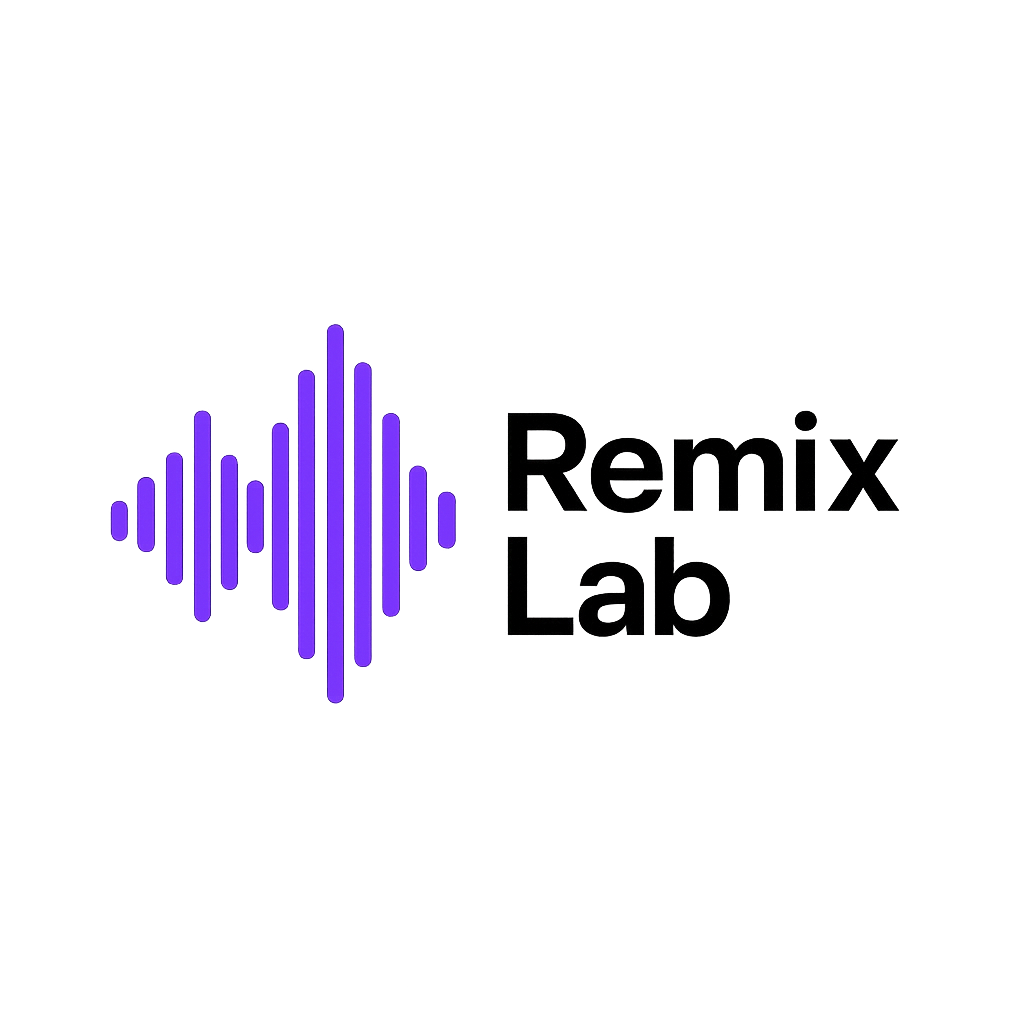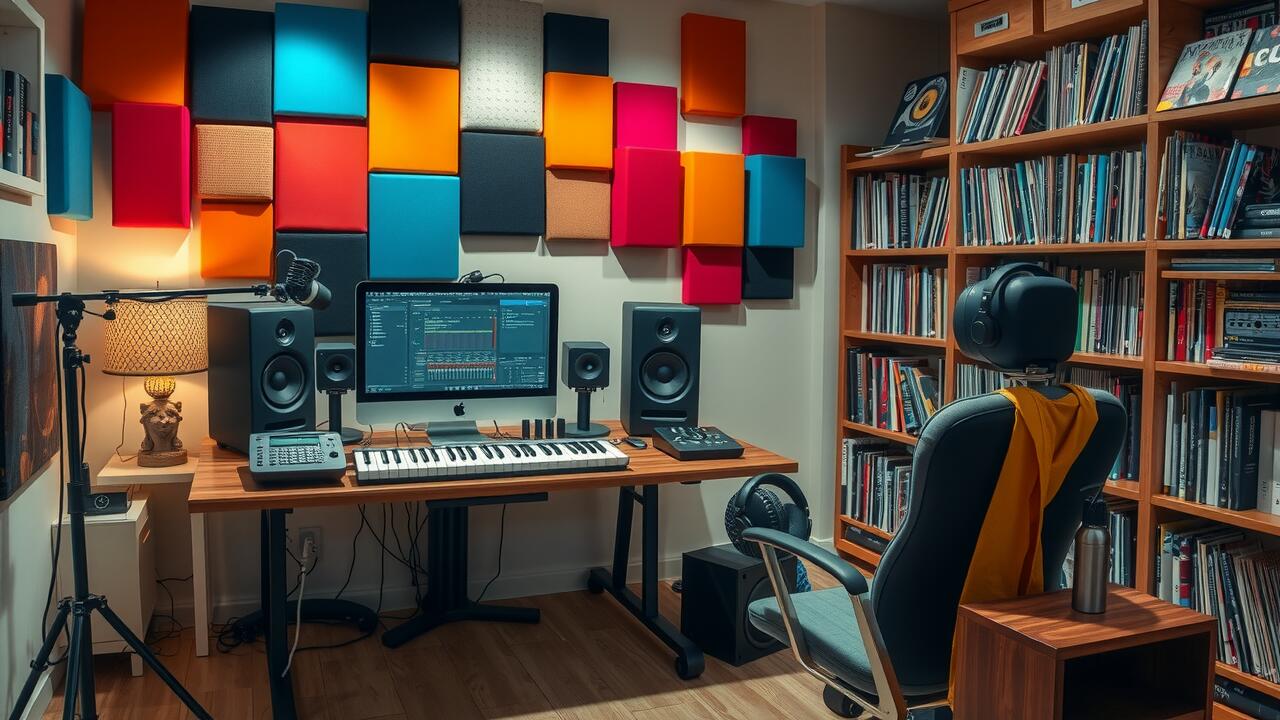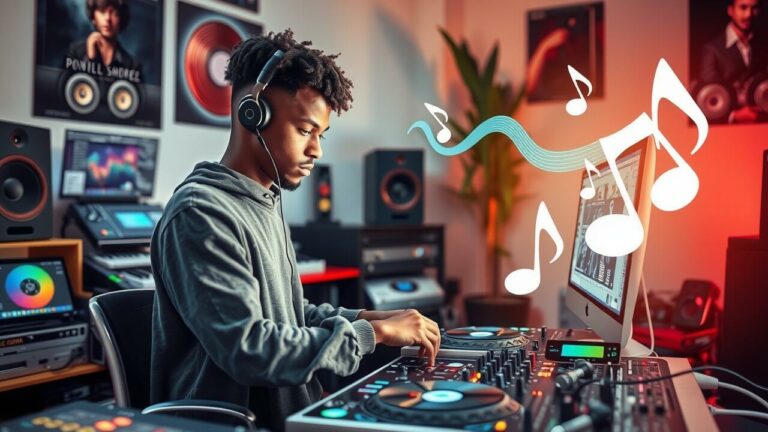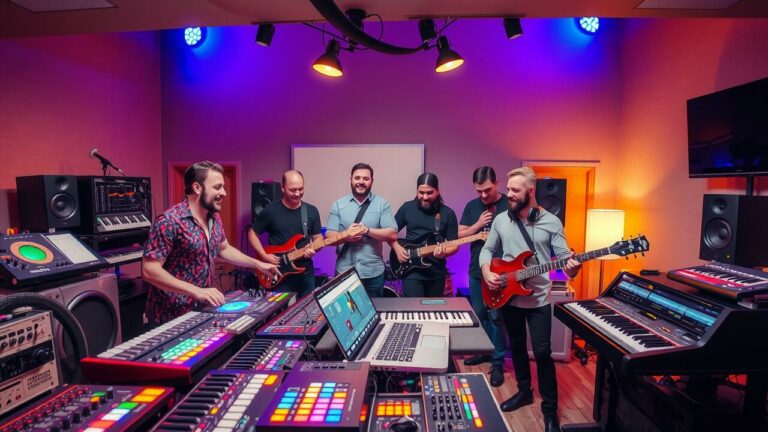Studio Setup Guide: Must-Have Music Gear for Aspiring Producers
Software Options for Music Production
The realm of music production software is a veritable cornucopia, brimming with an eclectic mix tailored to suit every skill level and production requirement. Digital Audio Workstations (DAWs) like Ableton Live, Logic Pro, and FL Studio each boast their own distinct features, catering not just to the greenhorns but also to the seasoned maestros of sound. Picture this: Ableton Live shines when it comes to live performances—its pulsating energy electrifies any stage! Meanwhile, Logic Pro garners accolades for its all-encompassing toolkit and MIDI prowess that leaves no stone unturned in creativity. And let’s not forget FL Studio—the darling of novices—with its intuitive interface beckoning those ready to dip their toes into beat-making and arrangement.
Now, as you embark on the quest to choose a DAW, it becomes paramount to consider specific functionalities that resonate with your unique workflow rhythm. Some platforms may cater exquisitely well for crafting electronic masterpieces while others flourish in the hallowed halls of recording studios. The compatibility dance with third-party plugins and hardware often tips the scales in your decision-making journey. And what’s more? Many DAWs graciously offer trial versions—an invitation for potential users to immerse themselves before committing financially—to ensure a harmonious fit for their creative endeavors!
Comparing DAWs
Digital Audio Workstations (DAWs) are the very lifeblood of music production, each pulsating with its own distinctive features, sculpted for various workflows. Some DAWs shine brightly with user-friendly interfaces that beckon newcomers to dive in—perfect for those just stepping into the sonic realm. On the flip side, there are others that flaunt sophisticated capabilities, tailored for seasoned producers who crave intricate sound design and nuanced control over their audio landscapes. The decision-making maze is often influenced by a medley of factors: MIDI editing finesse, robust audio recording functionalities, and an arsenal of built-in plugins can dramatically sway one’s choice.
Then there’s compatibility—a pivotal player in this selection saga. Producers must ponder whether their selected DAW will harmonize effortlessly with their MIDI controllers, audio interfaces, and all manner of other gear strewn about their creative sanctuaries. And let’s not overlook community support; a vibrant tapestry of tutorials and forums can elevate the learning experience to new heights. By dissecting these elements thoughtfully, aspiring producers can unearth a DAW that resonates perfectly with both their artistic aspirations and technical needs—an ideal marriage between creativity and technology!
MIDI Controllers
MIDI controllers—oh, how they pulse with life in the realm of music production! These indispensable gadgets transform the way producers weave their sonic tapestries, offering a tactile playground for composing and arranging. Imagine: each button press and key strike unleashes a wave of expressive potential over virtual instruments and software tools, crafting an intuitive journey through creativity’s labyrinthine corridors.
Diverse as the genres they cater to, MIDI controllers come in a smorgasbord of styles—keyboard controllers beckon with their familiar keys; pad controllers entice with rhythmic possibilities; hybrid models dance between both worlds. The quest for that perfect controller is no mere shopping trip; it’s about unlocking workflow magic, effortlessly morphing fleeting musical ideas into vibrant digital realities.
As you sift through your options in this ever-expanding universe of MIDI marvels, keep an eye on several pivotal features. Consider the number of keys or pads at your disposal—a symphony awaits those who choose wisely! Sensitivity to touch can elevate your playing experience from mundane to mesmerizing. And don’t overlook those additional knobs and sliders—they’re not just accessories but gateways to deeper control! Compatibility with favored digital audio workstations (DAWs) looms large too, crucial for ensuring everything clicks together seamlessly like pieces of a well-crafted puzzle.
For aspiring producers venturing forth into this electrifying landscape, exploring choices that align not only with budget constraints but also resonate with personal genre affinities and production techniques is essential. Dive deep into the possibilities—the right MIDI controller might just be your golden ticket to sonic exploration!
Features to Consider When Buying
When diving into the world of MIDI controllers, a plethora of essential features demands your attention to make sure it meshes perfectly with your production aspirations. The sheer number of keys and pads can dramatically shape not just how you play but also how smoothly your workflow flows. You’ll find an eclectic range—everything from nimble 25-key models that fit snugly on a desk to grandiose 88-key behemoths that beckon for more space. Sensitivity and velocity response? Absolutely crucial! These factors dictate the depth and nuance of your musical expression, transforming simple notes into vibrant performances.
And let’s not forget about connectivity—a pivotal element in the usability equation. While USB connections have become the norm, having MIDI DIN ports can unlock a realm of versatility when linking up with other hardware devices. It’s vital to consider integration prowess with various digital audio workstations (DAWs). Some controllers boast pre-mapped settings tailored for popular software, making setup feel like a breeze instead of a chore! Build quality is another factor worth pondering; if you’re frequently on the move with your gear, you’ll want something robust enough to endure constant travel yet light enough so it doesn’t weigh you down like an anchor.
So as you sift through options galore, remember: each feature plays its part in crafting not just a tool but an extension of your artistic voice!
| MIDI Controller Model | Number of Keys | Connectivity Options | Velocity Sensitivity | DAW Compatibility |
|---|---|---|---|---|
| Alesis V25 | 25 | USB | Yes | Compatible with most DAWs |
| Native Instruments Komplete Kontrol S88 | 88 | USB, MIDI DIN | High sensitivity | Pre-mapped for Ableton, Logic, etc. |
| Akai MPK Mini MK3 | 25 | USB | Yes | Compatible with most DAWs |
| Arturia KeyLab 61 MkII | 61 | USB, MIDI DIN | High sensitivity | Pre-mapped for major DAWs |
Impact of Studio Headphones
The selection of studio headphones wields a profound impact on the very fabric of your music production journey. Imagine this: accurate monitoring, like a finely tuned instrument, allows producers to unearth those delicate nuances that might otherwise slip through the cracks in their mixes—each element poised to shine just as it was envisioned. High-quality headphones work wonders by minimizing sound coloration; they create a neutral listening arena where choices about tracks can be made with clarity and precision. Whether you’re deep into mixing or fine-tuning during mastering, that crystal-clear sound reproduction is paramount for achieving results that radiate professionalism.
But wait, there’s more! Studio headphones are not one-size-fits-all; they cater to diverse listening environments and personal quirks alike. Closed-back designs thrive in raucous surroundings, wrapping you in an isolating cocoon, while open-back models serenade you with a lushly natural auditory experience. Comfort becomes king here—the right fit isn’t just nice to have; it’s essential because long sessions can wear down both ears and mind alike. Investing in a trustworthy pair? Absolutely crucial! It keeps producers locked into focus and productivity mode, allowing them to shower their projects with the care they truly deserve.
Why Quality Monitoring is Crucial
Quality monitoring stands as a cornerstone in the realm of music production, wielding immense influence over how sound is represented with precision. Imagine this: if producers are equipped with subpar headphones or studio monitors, they risk slipping into a quagmire of misjudged levels, skewed EQs, and a mix that feels off-kilter. The result? A sonic landscape that morphs unexpectedly across various playback systems—what sounds rich and vibrant on one device might crumble into disappointment on another. This disconnect breeds frustration not just for the producer wrestling with their craft but also for the audience yearning for an authentic auditory experience. Both artists and listeners hold expectations—that music should resonate beautifully whether it’s blasting from high-end speakers or trickling through tiny earbud headphones.
In this intricate dance of sound, precision in monitoring becomes critical listening’s best ally—a necessity when it comes to crafting informed mixing and mastering choices. Investing in top-tier monitoring tools isn’t merely a suggestion; it’s essential! These devices capture the nuanced subtleties of each track—the ebb and flow of dynamics, the delicate balance of tones—with clarity that can make all the difference. Professionals lean heavily on this high-fidelity playback like a compass guiding them through uncharted waters toward a polished final product that dazzles amidst fierce competition. Thus, overlooking quality monitoring isn’t just careless; it can stifle a producer’s growth while inadvertently capping their creative horizons—a fate no artist wishes to encounter!
Building a Versatile Recording Setup
A dynamic recording setup, brimming with versatility, opens the floodgates to a myriad of styles and techniques, inviting producers to dive deep into the ocean of creative possibilities. By investing in essential components—think microphones that sing with clarity, audio interfaces that serve as the lifeline between your instruments and computer, and acoustic treatment that tames unruly echoes—you can dramatically elevate your recording quality. A stellar microphone doesn’t just capture vocals; it brings life to instruments too—a true cornerstone for any studio sanctuary.
Now, let’s not forget about those crucial accessories! Pop filters swoop in like silent guardians against plosive sounds, smoothing out vocal recordings with grace. Meanwhile, a robust mic stand stands tall (and steady), offering both stability and flexibility during those intense recording sessions where every note counts. And what about cables and power strips? They may seem mundane but are absolutely vital—the unsung heroes ensuring reliable connections are maintained so signal integrity remains unblemished.
In essence, crafting a well-thought-out setup means harmonizing quality gear with clever accessories—it’s all about creating an environment ripe for creativity to flourish and productivity to soar!
Essential Accessories You Shouldn’t Ignore
Crafting a vibrant studio atmosphere demands more than just creativity; it hinges on the right accessories that can elevate your workflow and sound quality to new heights. Enter acoustic treatment panels—these unsung heroes are essential for taming unruly sound reflections, ushering in a listening experience that’s not just clearer but downright immersive.
And let’s not forget about microphone stands and pop filters! They’re the dynamic duo of recording, enhancing audio fidelity while lending an air of professionalism to your setup. Imagine reducing those pesky background noises and banishing unwanted pops—a game-changer for any serious artist or engineer.
But wait—cables and adapters also deserve their moment in the spotlight! Don’t underestimate these vital components; high-quality audio cables can be the difference between mediocre sound and pristine clarity. Investing in a solid audio interface? Absolutely crucial—it acts like a bridge, connecting your computer with studio microphones, making every recording session feel direct, precise, almost magical. Each accessory contributes its own unique flair to this intricate tapestry we call production, weaving together an environment where creativity can truly flourish.
Budgeting for Your Studio Setup
Crafting a functional music studio is no small feat—it’s like orchestrating a symphony of dollars and sense, balancing your ambitions against the harsh realities of your budget. Begin by sketching out what you absolutely cannot live without. What are the cornerstone instruments for your unique production vibe? Think Digital Audio Workstation (DAW), MIDI controller, those all-important headphones, and an audio interface that sings to your soul. Pinpointing these essentials can be a lifeline in navigating the tempestuous waters of gear acquisition, steering clear of impulsive splurges on flashy gadgets that’ll gather dust.
But wait! There’s treasure to be found in cost-effective alternatives that don’t skimp on quality. Many brands roll out entry-level marvels—products that pack a punch but won’t send your finances spiraling into chaos. Have you considered scouring the secondhand market or capitalizing on seasonal sales? It might just lead you down paths less traveled where hidden gems await discovery! Moreover, diving deep into research could unveil lesser-known products boasting features mirroring their high-end counterparts—all while keeping more cash nestled comfortably in your pocket. So go ahead; let curiosity guide you as you venture forth in this exhilarating quest for sonic excellence!
Cost-effective Solutions for Aspiring Producers
Aspiring producers, listen up! You don’t have to drain your wallet to create a functional studio setup; it’s all about prioritizing the essentials. Consider this: entry-level gear can pack a punch without emptying your bank account. Think of those trusted brands—yes, they churn out affordable digital audio interfaces and studio monitors that boast impressive sound quality and reliability. And let’s not overlook the beauty of a solid entry-level digital audio workstation (DAW); it’s like unlocking a treasure chest of features for music production—all while keeping your finances in check.
But wait! There’s more—why not venture into the world of used or refurbished gear? It’s an adventure worth taking if you want high-quality tools at bargain prices. Scour online marketplaces or pop into local music shops; you might just stumble upon gold among second-hand equipment waiting for a new home. Plus, consider exploring free or low-cost software alternatives—they’re out there, ready to enhance your production prowess without costing an arm and leg. Many savvy software developers offer lite versions that could very well meet the needs of beginners dipping their toes into music creation. These budget-friendly choices empower aspiring producers to hone their craft effectively while sidestepping financial strain—it’s all possible with some clever decision-making!
- Invest in entry-level gear from trusted brands for reliable sound quality.
- Explore used or refurbished equipment to find high-quality tools at lower prices.
- Check out online marketplaces and local music shops for second-hand bargains.
- Look into free or low-cost software alternatives that suit beginner needs.
- Consider lite versions of popular DAWs to access essential features without the cost.
- Prioritize your purchases based on what you need most for your production goals.
- Keep an eye out for sales or discounts to make the most of your budget.
Conclusion
Embarking on the adventure of establishing a music studio is a thrilling yet daunting endeavor. The right gear and software can elevate your production prowess to new heights—it’s like unlocking hidden realms of creativity! But, oh, the labyrinthine choices! A thoughtful examination of your specific needs and financial considerations is absolutely vital in pinpointing the perfect tools that resonate with your creative spirit.
As you meander through an array of options, piecing together your setup, keep in mind that every single component plays a pivotal role in shaping both your workflow and sound quality. It’s all about striking that delicate balance: prioritize those must-have items while keeping an eye out for future enhancements. This approach lays down a sturdy foundation for all your musical compositions to soar from. So go ahead—embrace that boundless creative potential within you and let your studio transform into a vibrant catalyst for realizing your artistic dreams!
FAQS
What’s the key software for music creation?
Ah, the cornerstone of music production lies in a Digital Audio Workstation (DAW). Think of it as your creative playground! Renowned choices like Ableton Live, FL Studio, and Logic Pro X each boast their own distinctive flair. The trick? Find one that resonates with your unique workflow and stylistic preferences—it’s all about synergy!
How do I select the perfect MIDI controller for my studio?
Ah, the quest for the ideal MIDI controller! Dive into features such as key count, pad sensitivity—how responsive does it feel under your fingers?—and ensure its compatibility with your chosen DAW. And don’t overlook those magical assignable knobs and sliders; they can elevate your control to new heights during music production!
Why are studio headphones crucial in music making?
Studio headphones are not just any ordinary audio gear; they’re vital tools that deliver precise sound reproduction while cutting out pesky external noise. This clarity is absolutely essential when you’re mixing and mastering tracks! With top-notch monitoring at play, producers can fine-tune every nuance of their creations, ultimately enhancing overall sound quality.
What accessories should grace my recording setup?
Essential accessories for an optimal recording setup include a pop filter to tame plosives, a sturdy microphone stand to keep things stable, acoustic treatment panels to refine sound dynamics—you get the picture—and high-quality cables that ensure clean signal flow. These components work together to elevate sound quality and streamline your recording experience.
How can I effectively budget for my studio dreamscape?
To masterfully navigate budgeting for your studio sanctuary, start by prioritizing gear and software that will wield significant influence over your productions. Embark on thorough research for cost-effective alternatives; don’t shy away from second-hand gems! And consider phased purchases—spreading costs over time can ease financial strain while you build up this musical haven piece by piece.







